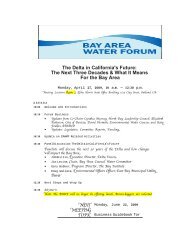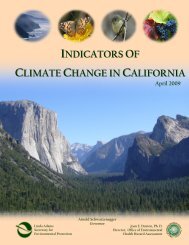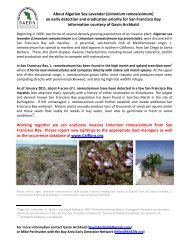Bird Species and Climate Change: The Global Status Report - WWF
Bird Species and Climate Change: The Global Status Report - WWF
Bird Species and Climate Change: The Global Status Report - WWF
You also want an ePaper? Increase the reach of your titles
YUMPU automatically turns print PDFs into web optimized ePapers that Google loves.
In Australia:■Arrival dates for 24 species <strong>and</strong>departure dates for 12 species of birdswere analysed using data spanningthe past 40 years. On average, birdsare arriving 3.5 days earlier per decadesince 1960, with half the speciesshowing significantly earlier arrival.<strong>The</strong>se results, reported by Beaumontet al. (2006), “add further evidencethat the modest warming experiencedover the past few decades has alreadyhad significant biological impacts on aglobal scale.”In Antarctica:■East Antarctic seabirds, including Adéliepenguins <strong>and</strong> six species of petrel, arearriving at their colonies an average of9.1 days later <strong>and</strong> laying eggs 2.1 dayslater than in the early 1950s. Some birdsare arriving as much as 30 days laterthan in the 1950s. <strong>The</strong> findings havebeen linked to global climate changewhich has decreased sea ice extent inthis region overall, but caused the seaiceseason to increase by more than 40days due to localised cooling since the1970s. <strong>The</strong>se changes are associatedwith declines in krill, a key prey species.<strong>The</strong> birds’ delayed arrival <strong>and</strong> layingdates may reflect the longer feedingtime to build up the energy reservesrequired to breed (Barbraud <strong>and</strong>Weimerskirch, 2006).3.1.2.2 Autumn departure shifts<strong>Bird</strong>s’ autumn departure dates alsoappear to be changing, however thiseffect is more difficult to monitor(Crick, 2004). This response to climatechange also appears more variable withsome species advancing <strong>and</strong> otherspostponing their autumn migration.<strong>The</strong>se differences appear to reflect therelative importance of summer <strong>and</strong>winter seasons in completing birds’ lifecycles (Lehikoinen et al., 2004).In Europe:■<strong>Bird</strong>s that winter south of the Saharahave advanced autumn migration anaverage of 2.5 days in the last 40 years,possibly so they can cross the Sahelbefore the seasonal dry period. Bycontrast, migrants wintering north of theSahara have delayed autumn passageby 3.4 days on average over the sameperiod (Jenni <strong>and</strong> Kery, 2003).In North America:■Of 13 North American passerine birdspecies, six were found to delay theirmigration dates in conjunction withglobal warming (Mills, 2005).3.1.2.3 Failure to migrateIn Europe it appears that climate changeis causing individuals of some birdspecies (which normally migrate) to failto migrate at all.This includes greenfinches, which haveseen a six-fold increase in their winterpopulations in Finl<strong>and</strong> in the last 40years, as fewer individuals migrateto Northern Germany (Lehikoinenet al., 2004).<strong>Bird</strong> <strong>Species</strong> <strong>and</strong> <strong>Climate</strong> <strong>Change</strong>: <strong>The</strong> <strong>Global</strong> <strong>Status</strong> <strong>Report</strong>20<strong>Climate</strong> Risk






